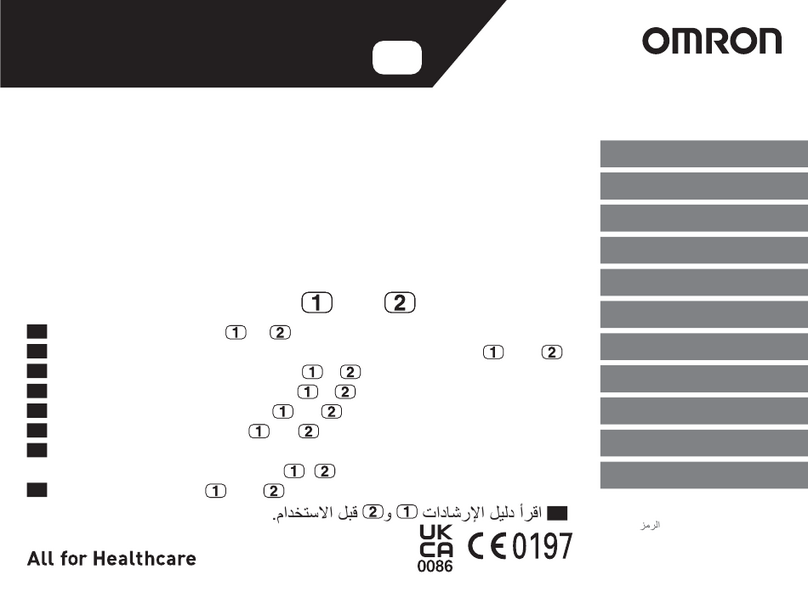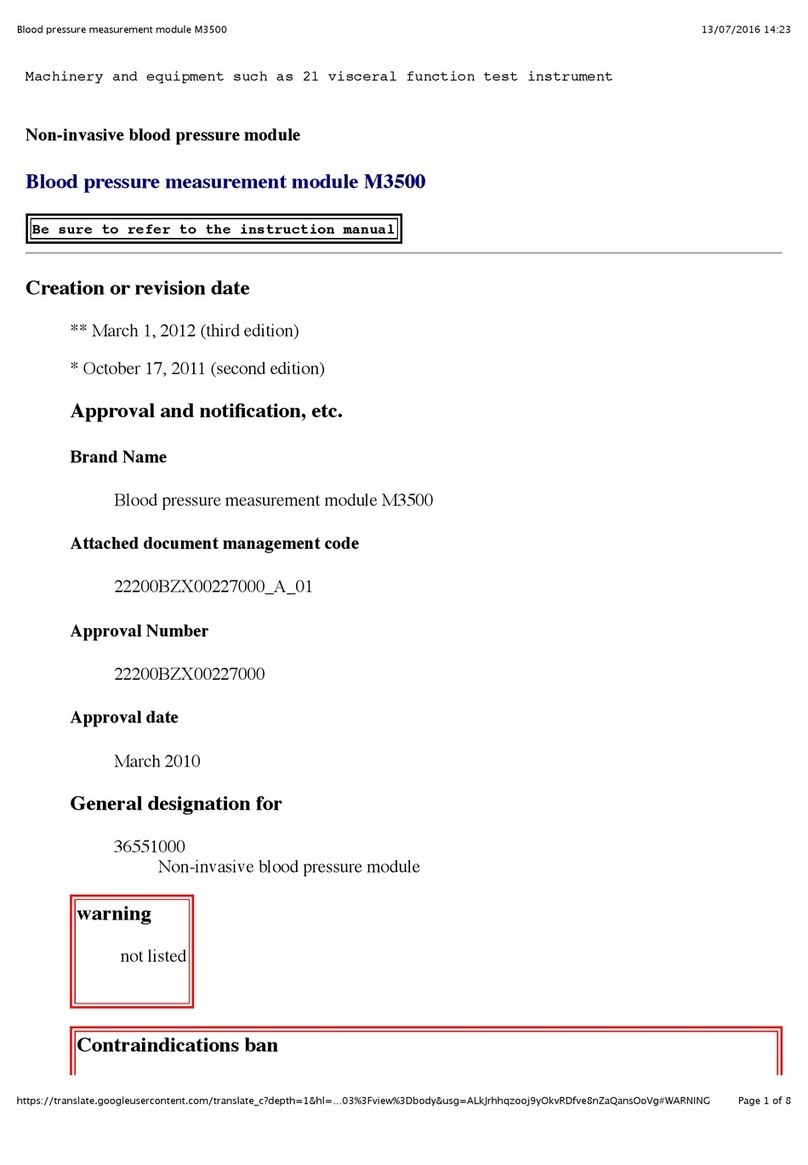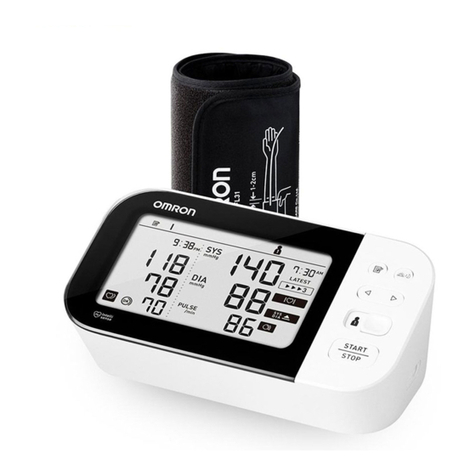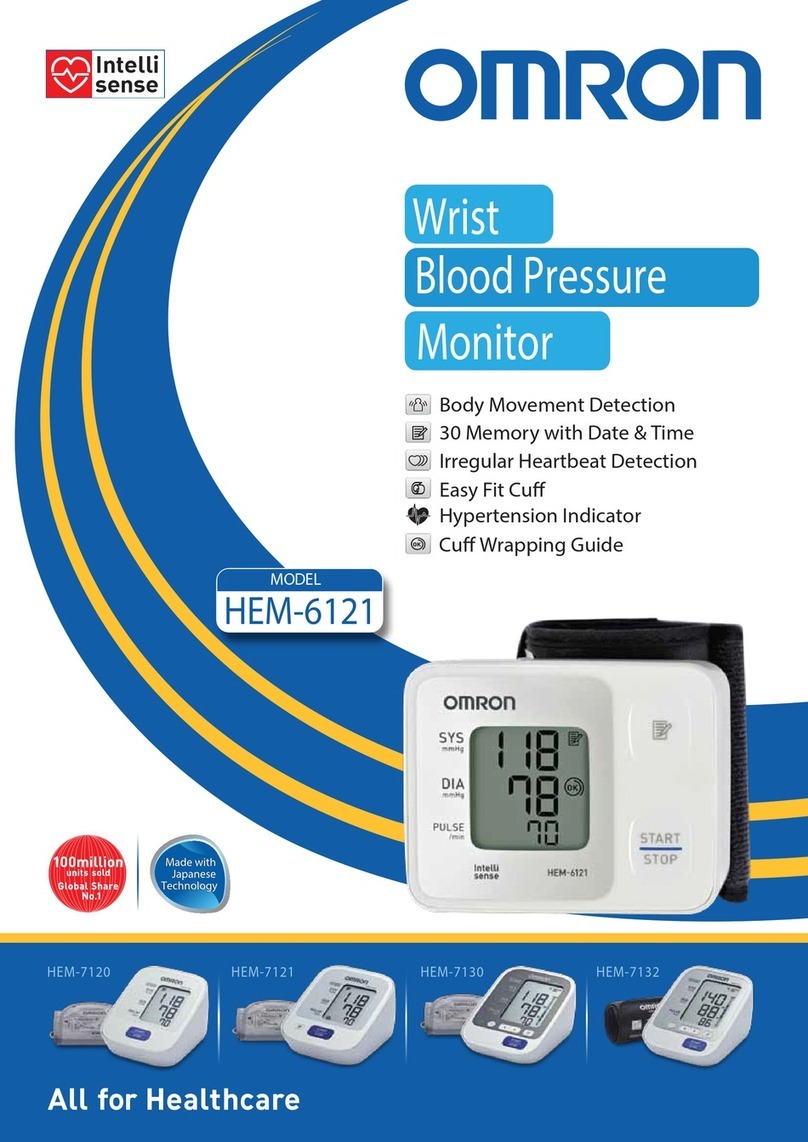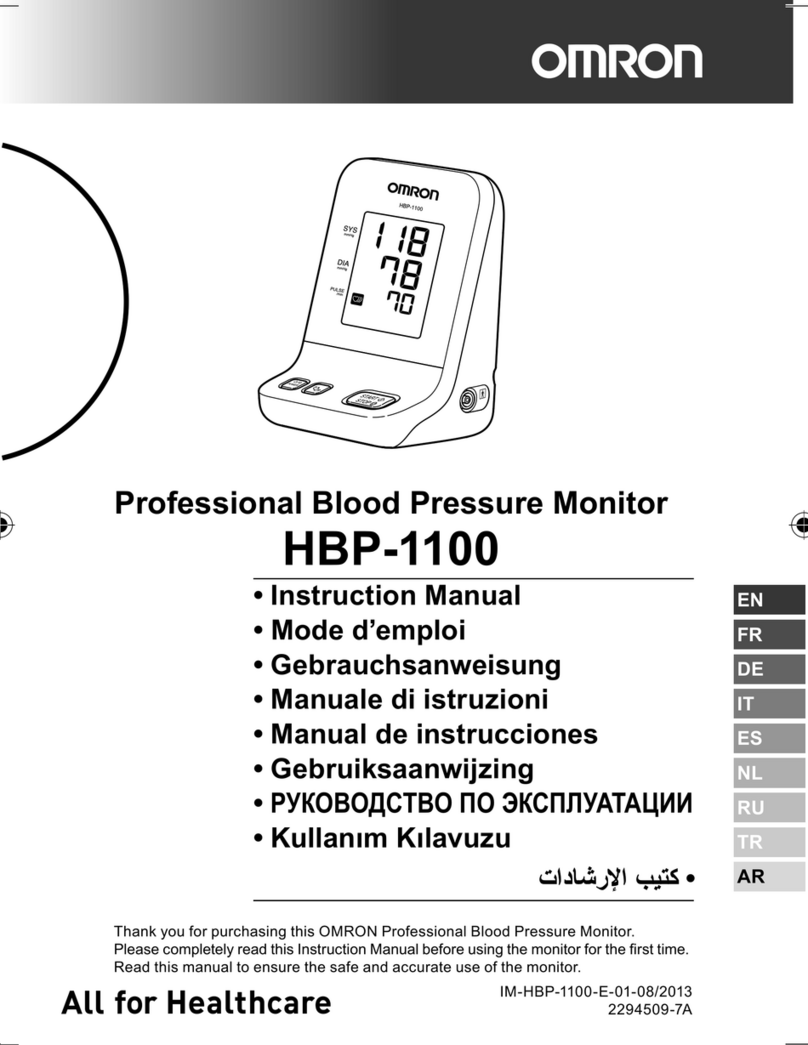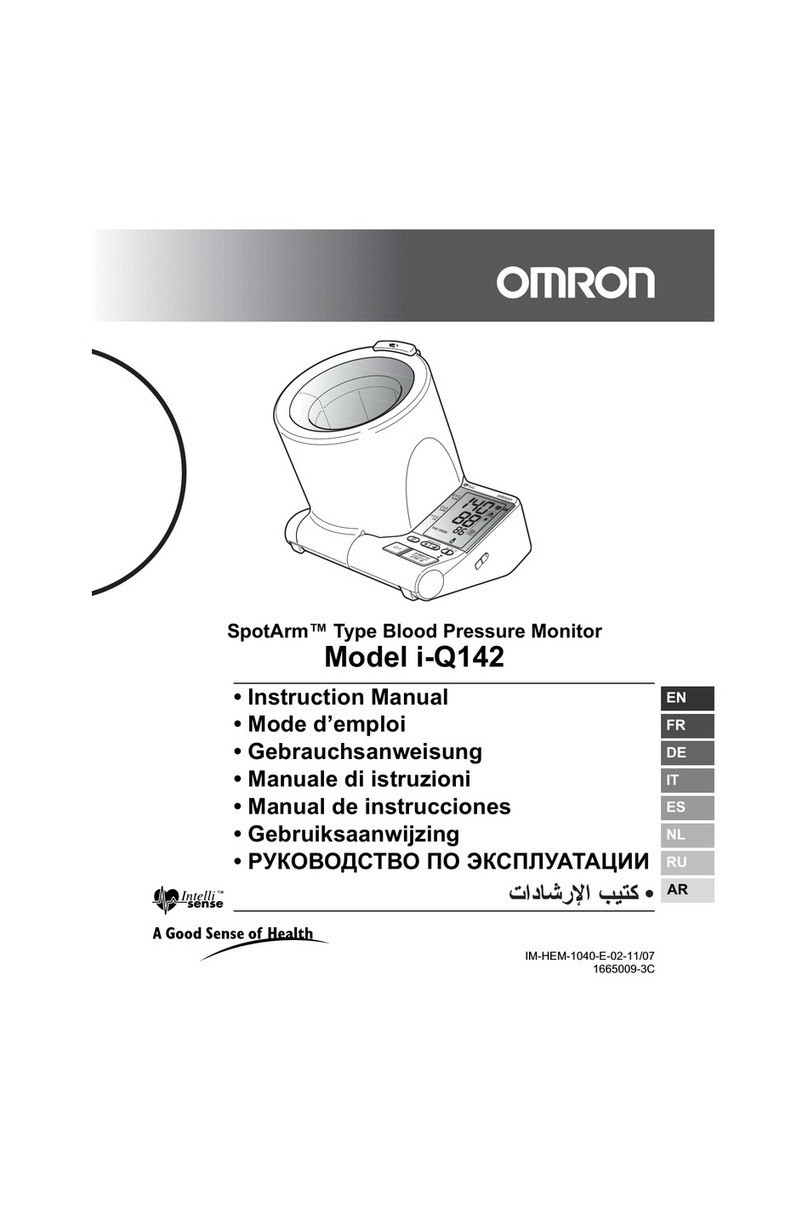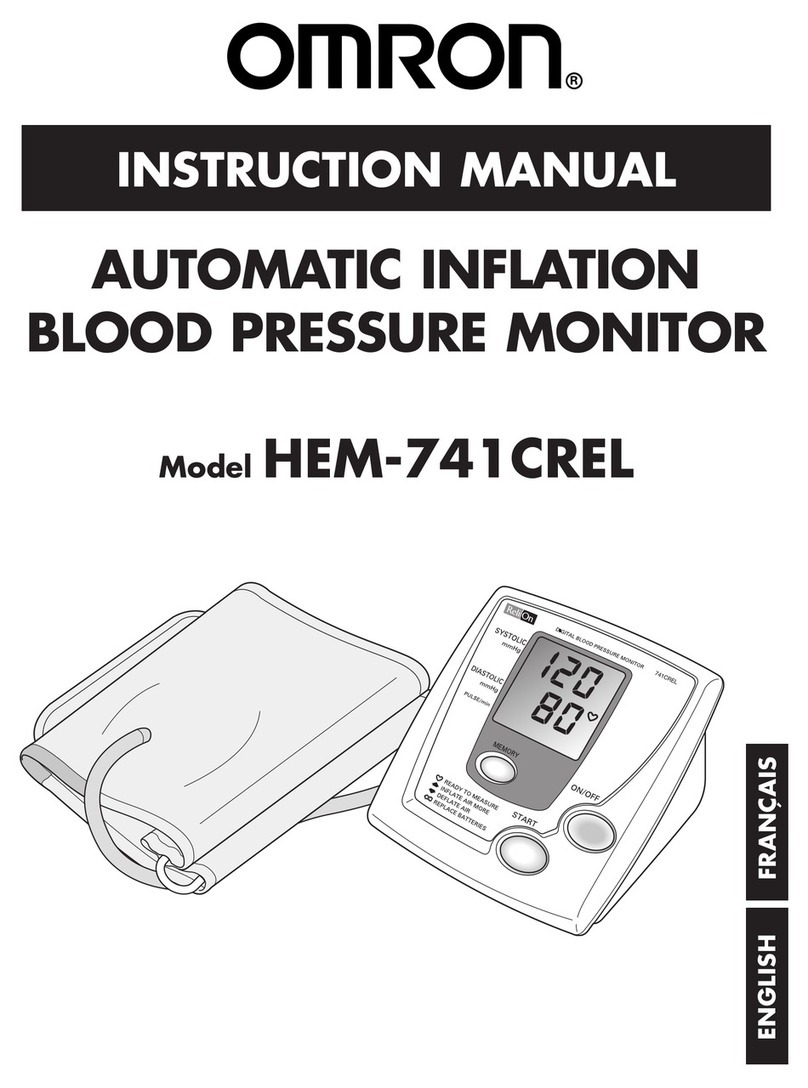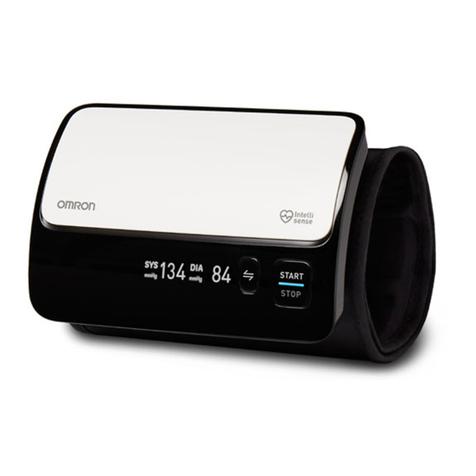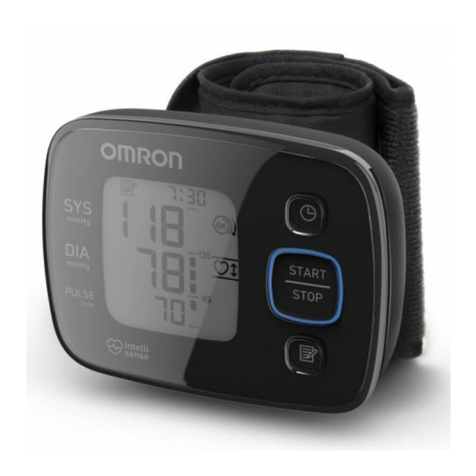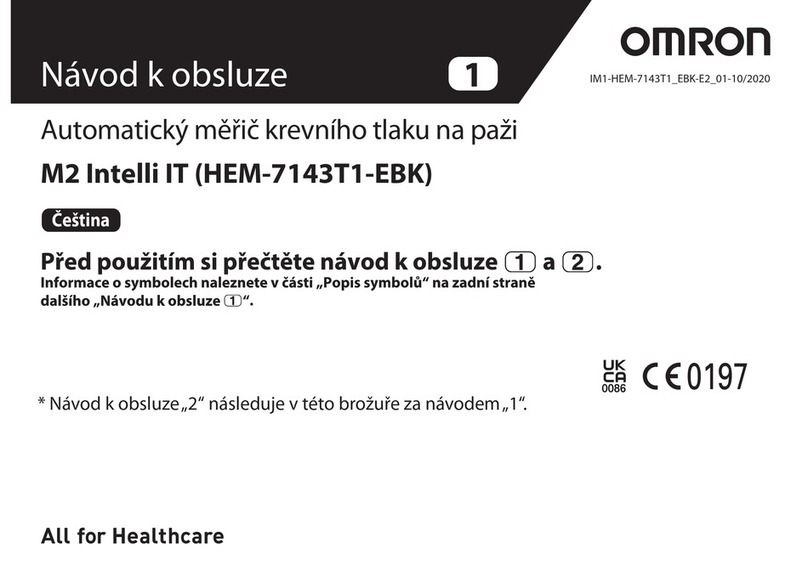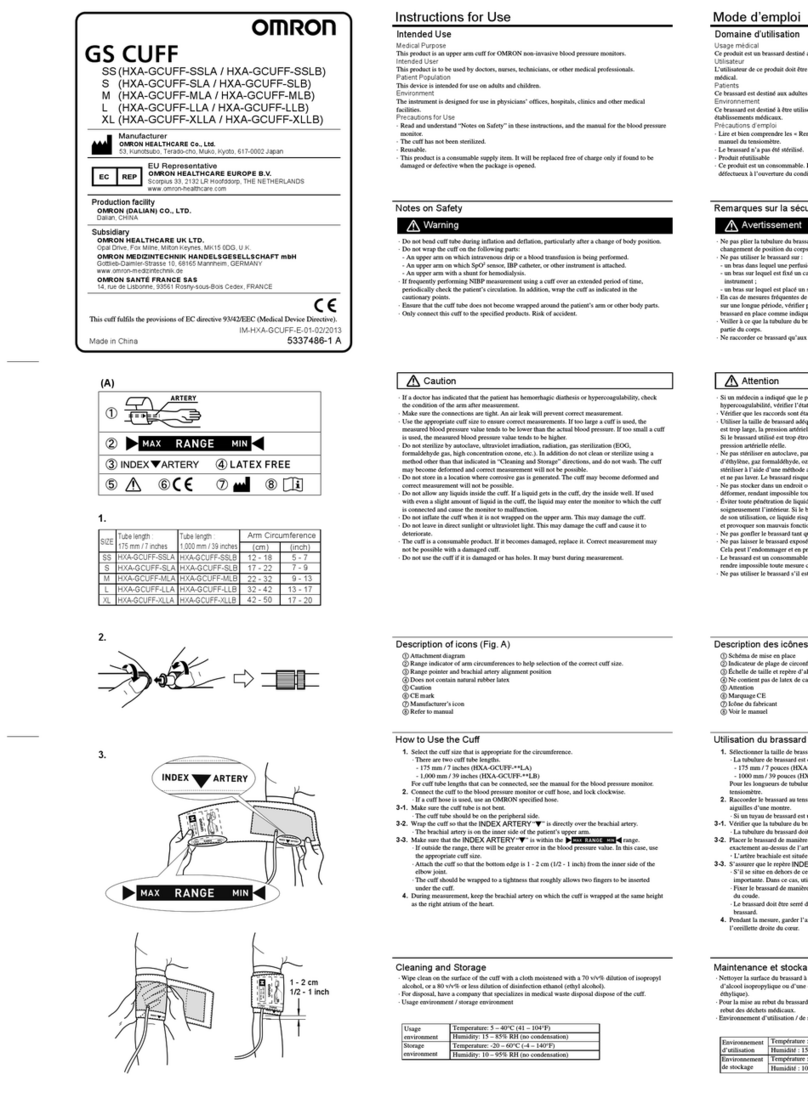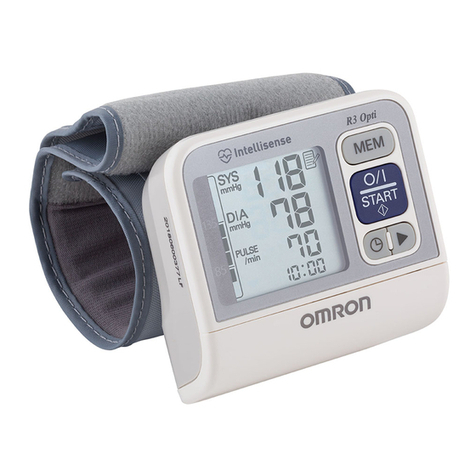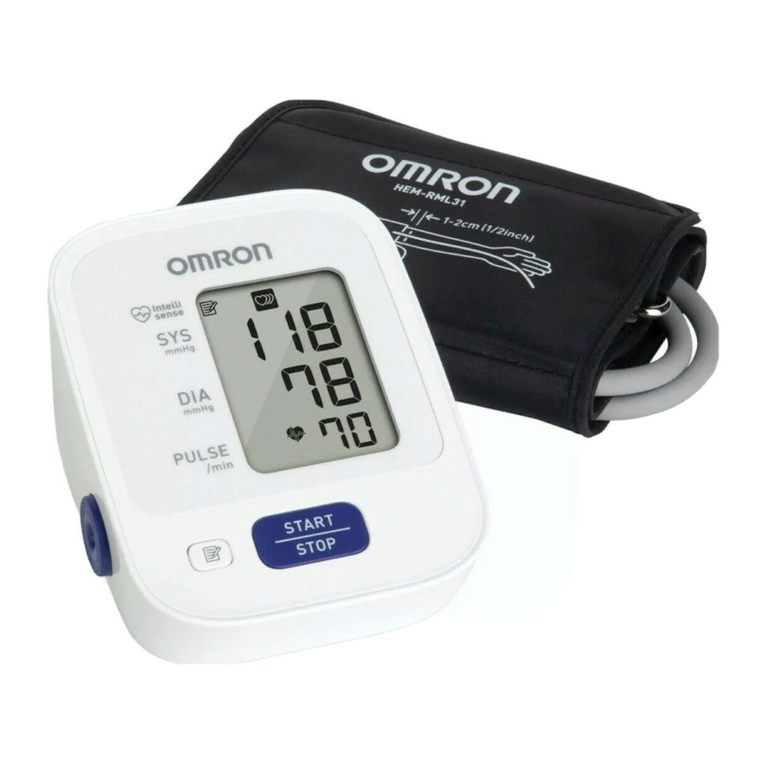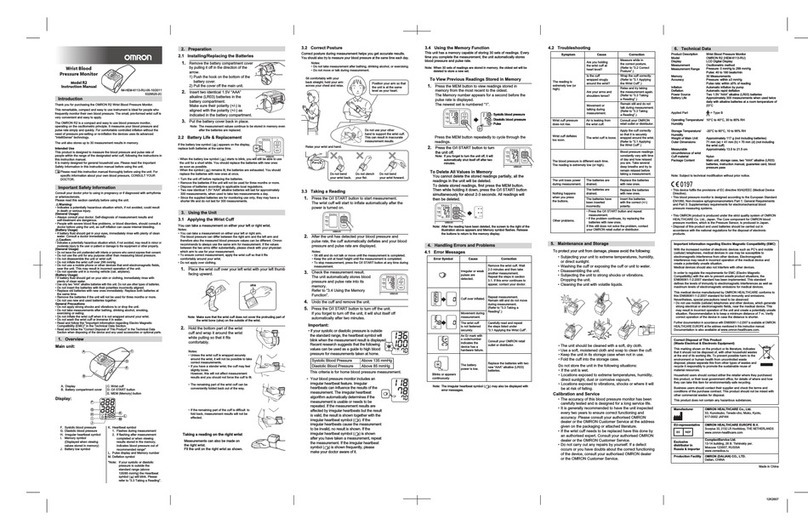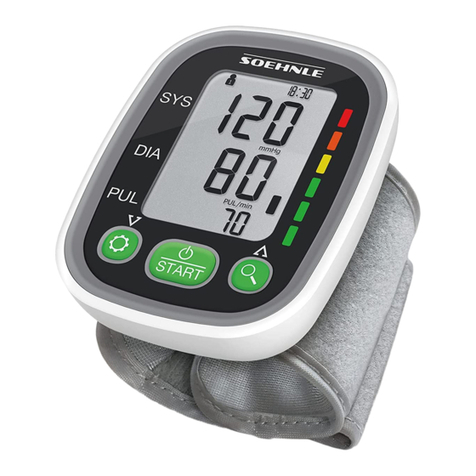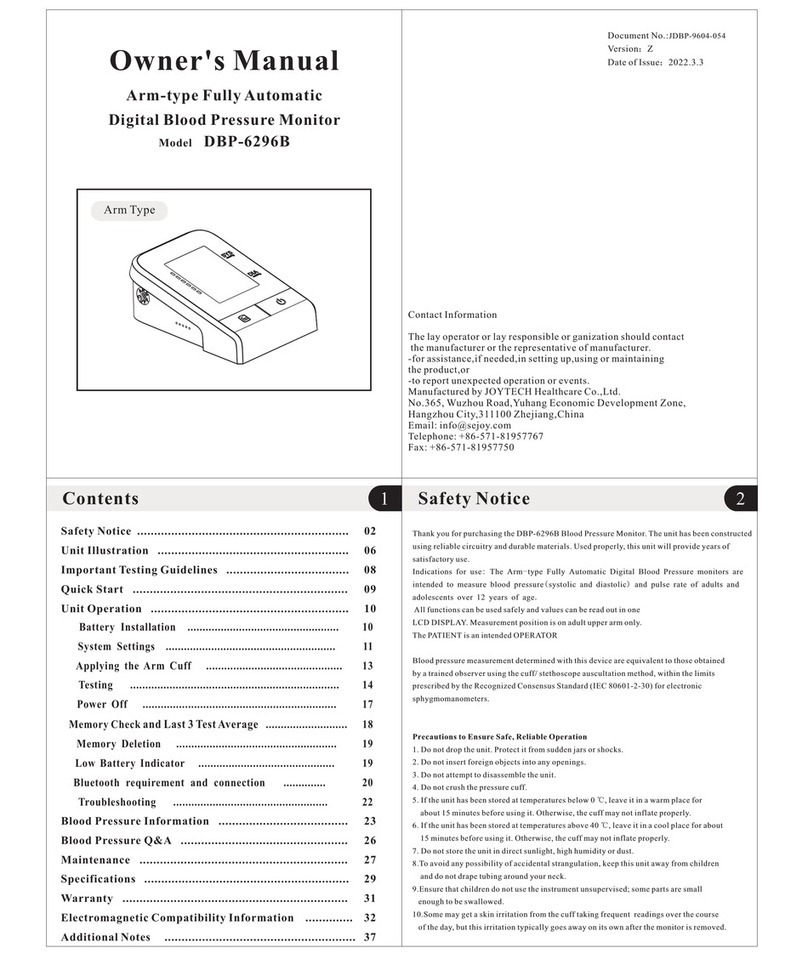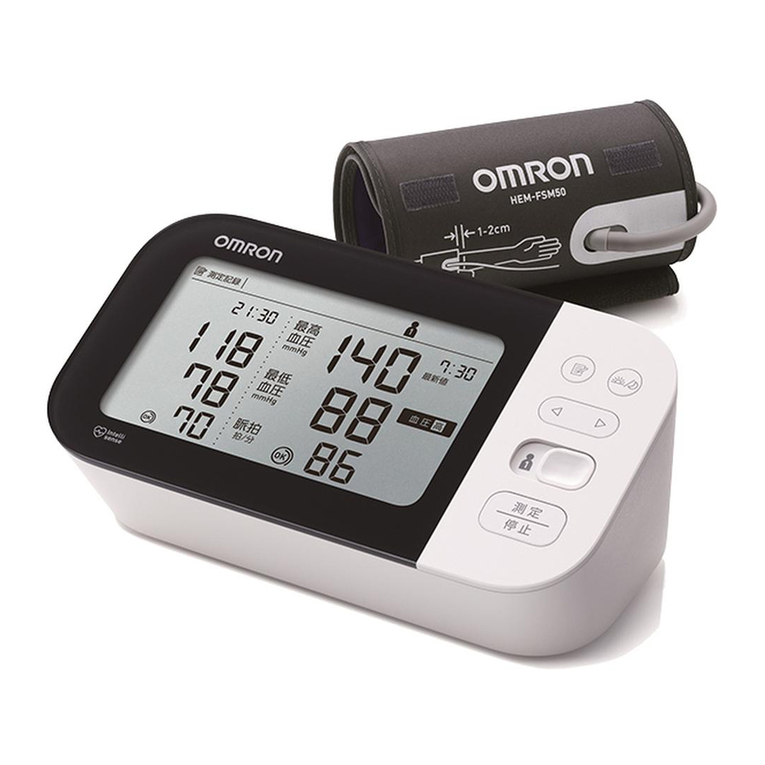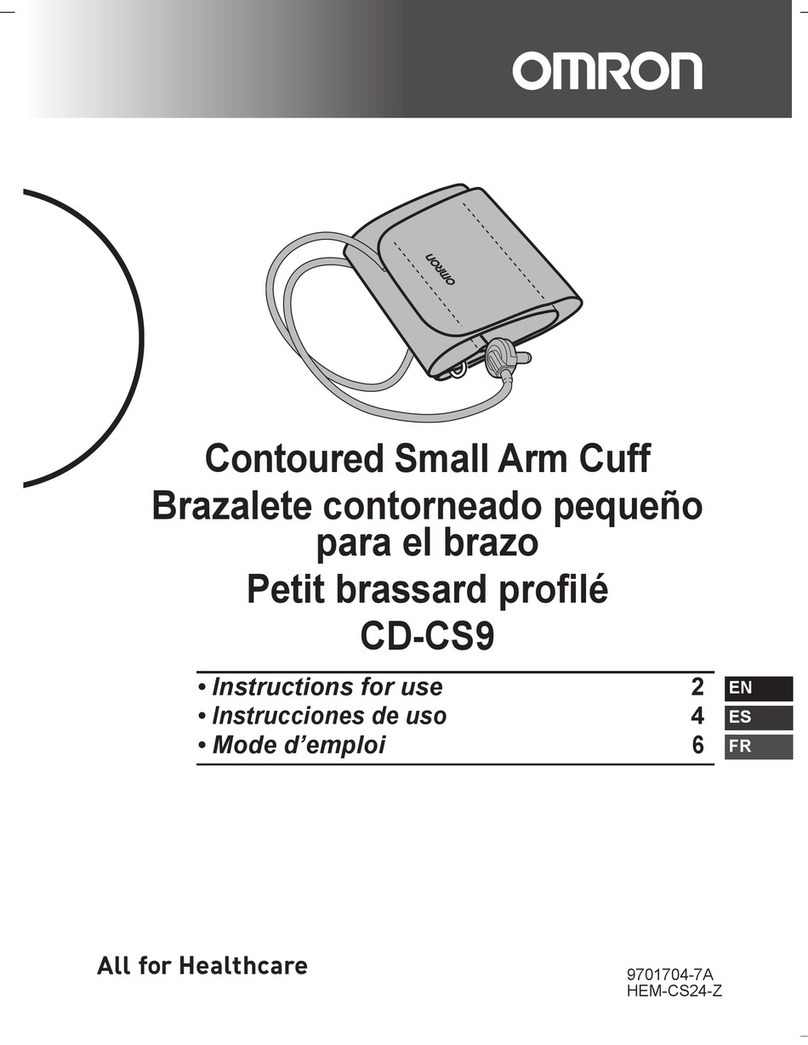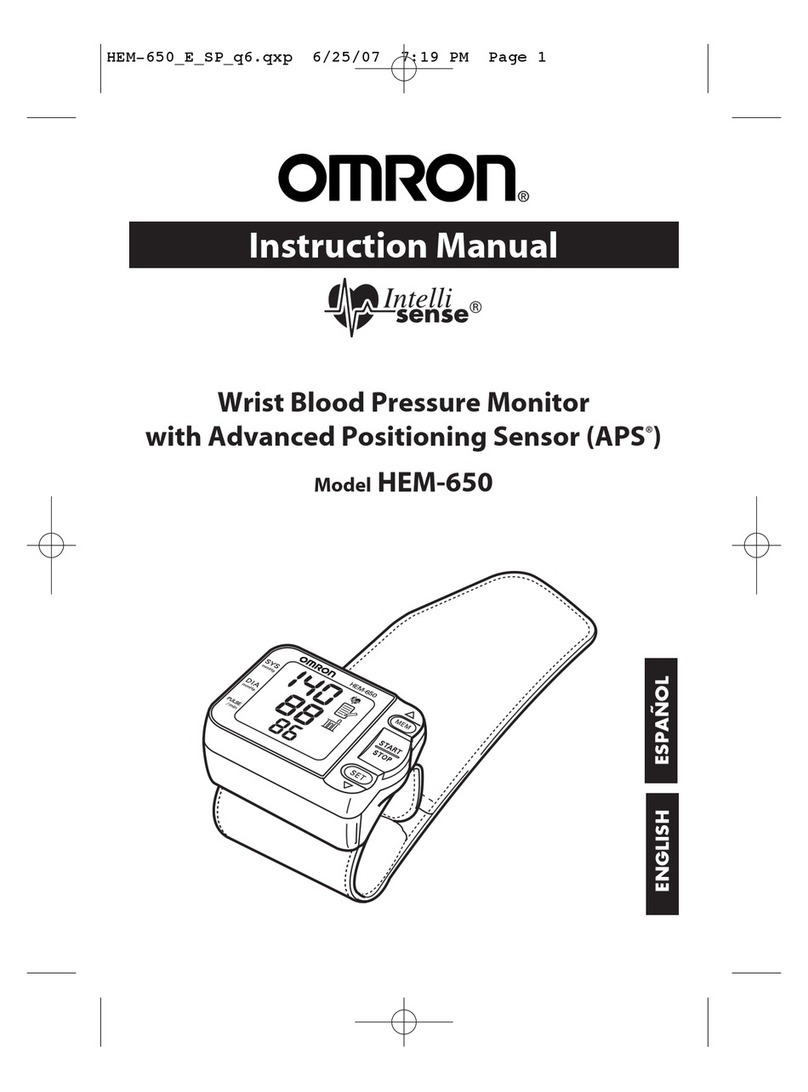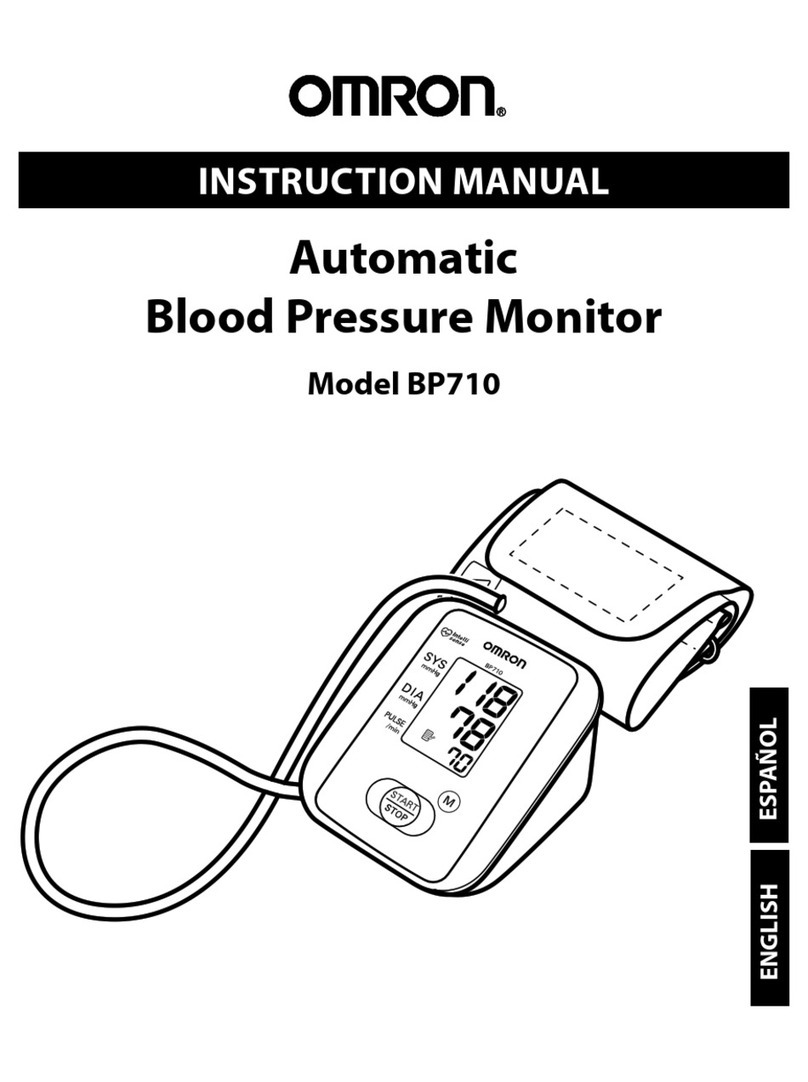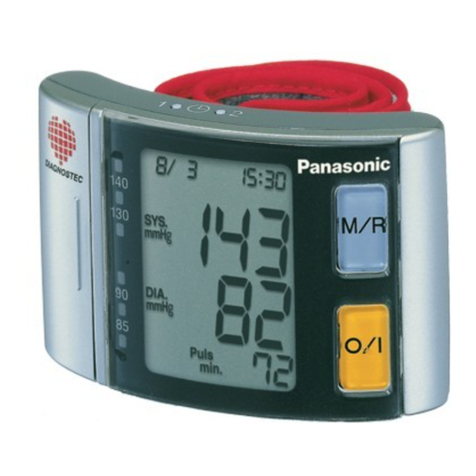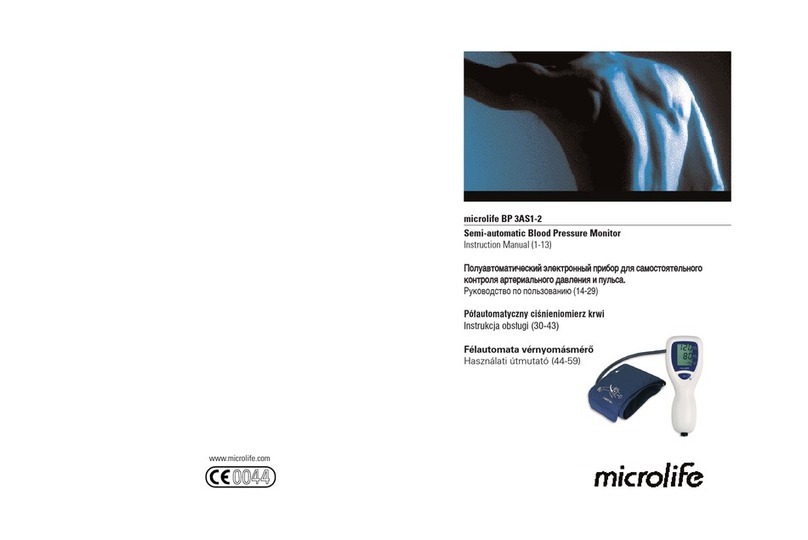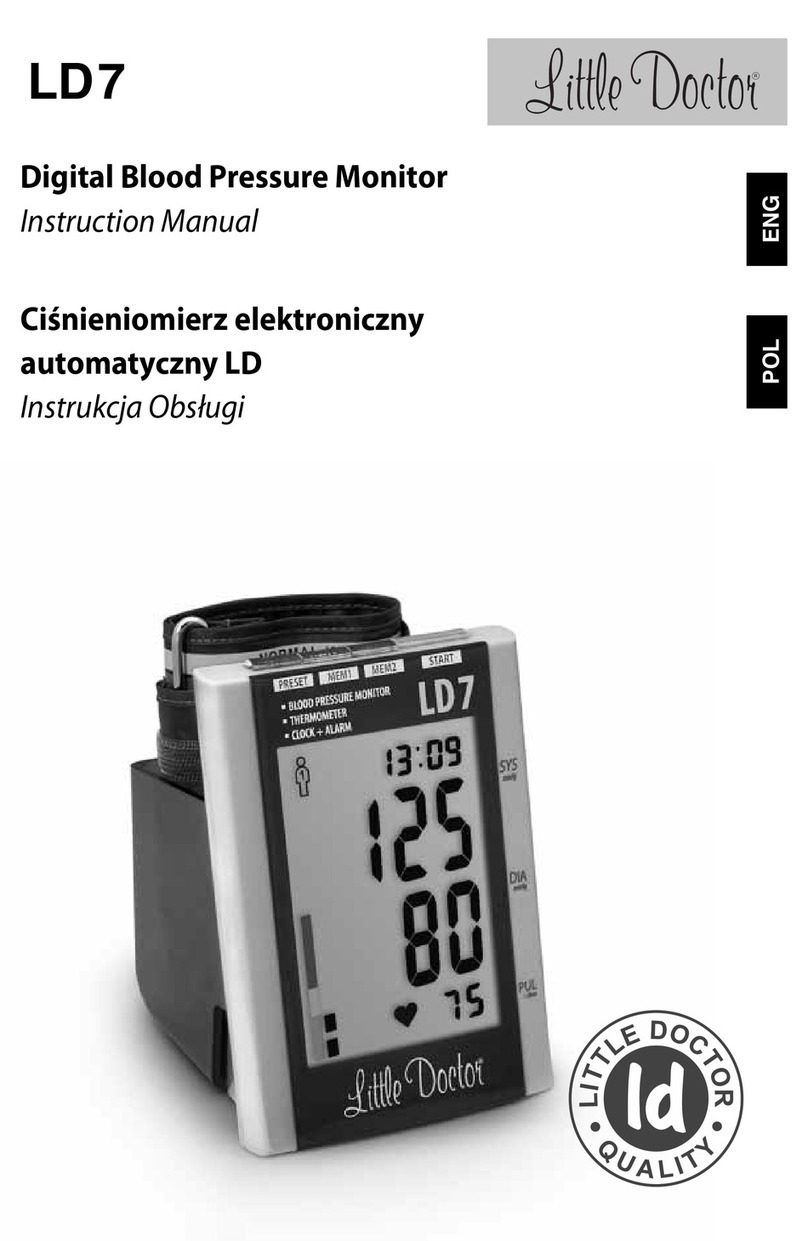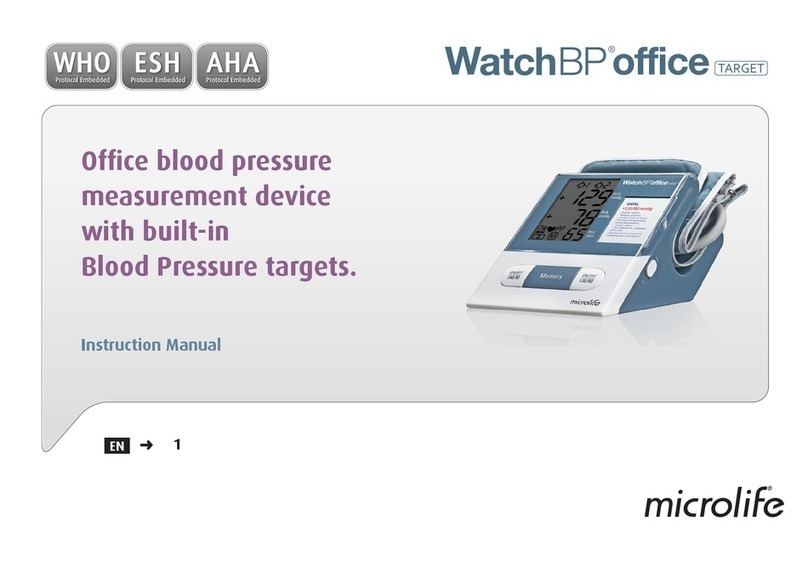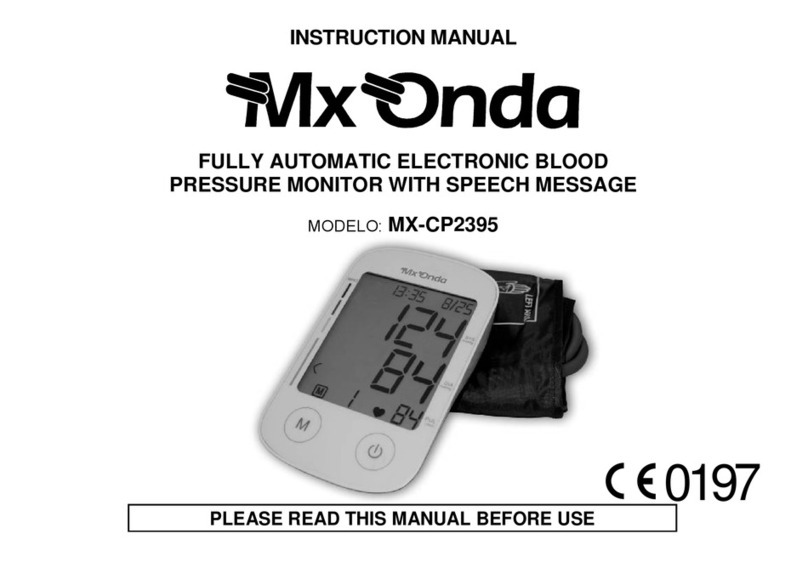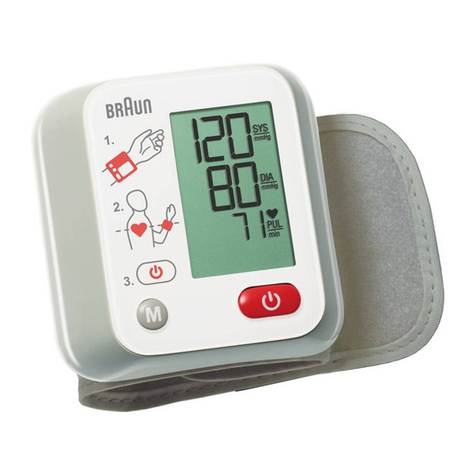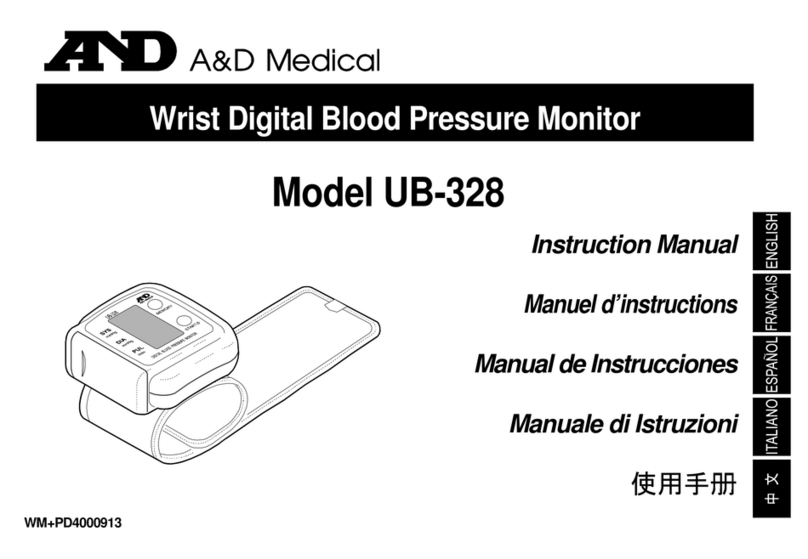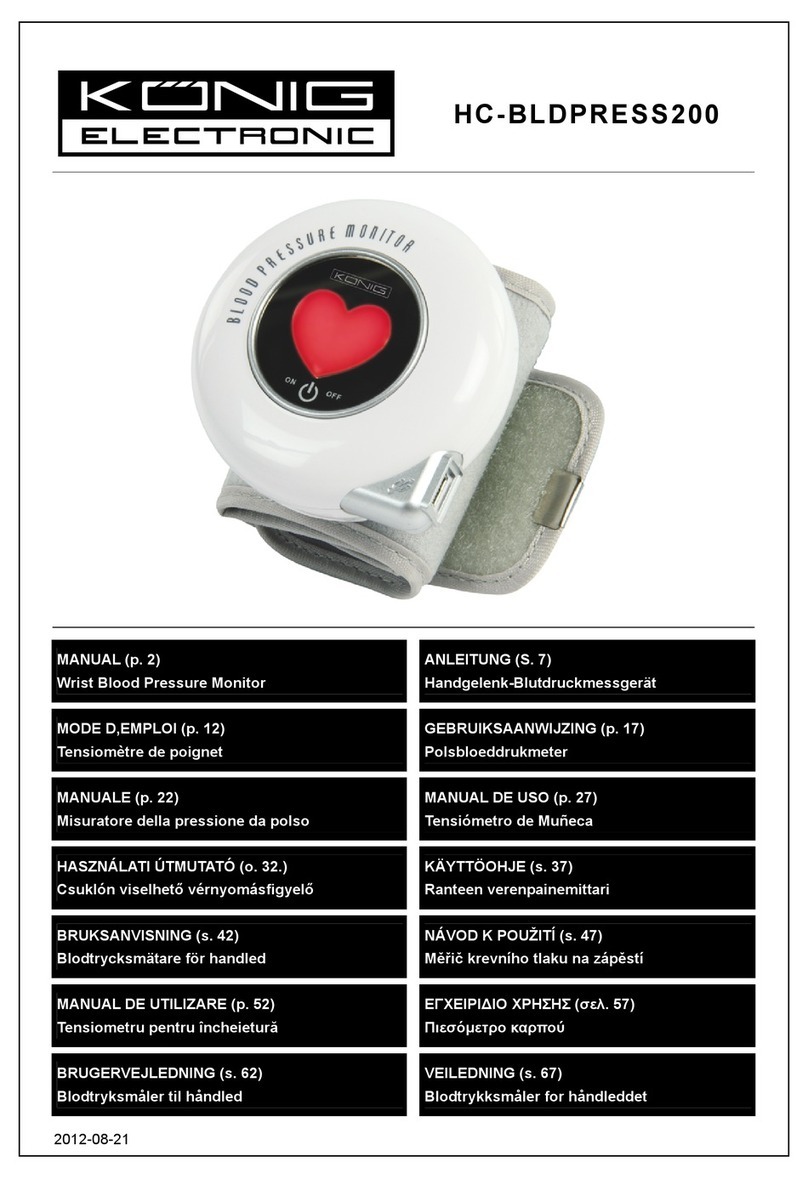4. Error Messages and Troubleshooting
4.1 Error Messages
4.2 Troubleshooting
5. Maintenance and Storage
5.1 Maintenance
To protect your device from damage, please follow the
directions below:
• Store the device and the components in a clean, safe
location.
• Do not use any abrasive or volatile cleaners.
• Do not wash the device and any components by
immersing them in water.
• Do not use gasoline, thinners or similar solvents to
clean the device.
• Use a soft dry cloth, or a soft cloth moistened with
neutral soap to clean on the monitor and the arm cuff.
• Changes or modification not approved by the
manufacturer will void the user warranty. Do not
disassemble or attempt to repair the device or
components.
5.2 Storage
1. Unplug the air plug from the air jack.
2. Gently fold the air tube into the
arm cuff.
Note: Do not bend or crease the air tube
excessively.
Do not store the device in the following situations:
•If the device is wet.
•Locations exposed to extreme temperatures, humidity, direct sunlight,
dust or corrosive vapors such as bleach.
•Locations exposed to vibrations, shocks or where it will be at an
angle.
5.3 Optional Accessories
Using the Optional AC Adapter
1. Insert the AC adapter
plug into the AC adapter
jack on the rear side of
the monitor.
2. Plug the AC adapter into
an electrical outlet.
To disconnect the AC adapter,
unplug the AC adapter from the electrical outlet first, and then remove
the AC adapter plug from the monitor.
6. Specifications
Notes:
• These specifications are subject to change without notice.
• In the clinical validation study, the 5th phase was used on 85 subjects
for determination of diastolic blood pressure.
• This device has not been validated for use on pregnant patients.
• IP classification is degrees of protection provided by IEC 60529.
7. FCC/IC Statement and Trademarks
FCC CAUTION
Changes or modifications not expressly approved by the party responsible
for compliance could void the user’s authority to operate the equipment.
Note:
This equipment has been tested and found to comply with the limits for a
Class B digital device, pursuant to part 15 of the FCC Rules. These limits are
designed to provide reasonable protection against harmful interference in a
residential installation. This equipment generates, uses and can radiate
radio frequency energy and, if not installed and used in accordance with the
instructions, may cause harmful interference to radio communications.
However, there is no guarantee that interference will not occur in a particular
installation. If this equipment does cause harmful interference to radio or
television reception, which can be determined by turning the equipment off
and on, the user is encouraged to try to correct the interference by one or
more of the following measures:
• Reorient or relocate the receiving antenna.
• Increase the separation between the equipment and receiver.
• Connect the equipment into an outlet on a circuit different from that to
which the receiver is connected.
• Consult the dealer or an experienced radio/TV technician for help.
This transmitter must not be co-located or operated in conjunction with any
other antenna or transmitter.
This equipment complies with FCC/IC radiation exposure limits set forth for
an uncontrolled environment and meets the FCC radio frequency (RF)
Exposure Guidelines and RSS-102 of the IC radio frequency (RF) Exposure
rules. This equipment has very low levels of RF energy that are deemed to
comply without testing of specific absorption ratio (SAR).
This Product operates in the unlicensed ISM band at
2.4GHz. In case this Product is used around the other
wireless devices including microwave and wireless LAN,
which operate same frequency band of this Product,
there is a possibility that interference occurs between
this Product and such other devices. If such interference
occurs, please stop the operation of other devices or
relocate this Product before using this Product or do not
use this Product around the other wireless devices.
The Bluetooth®Smart word mark and logos are
registered trademarks owned by Bluetooth SIG, Inc. and
any use of such marks by OMRON HEALTHCARE
Co., Ltd. is under license. Other trademarks and trade
names are those of their respective owners.
8. Limited Warranty
Your HEM-9200T Automatic Blood Pressure Monitor, excluding batteries, is
warranted to be free from defects in materials and workmanship appearing
within 2 years from the date of purchase, when used in accordance with the
instructions provided with the monitor. The above warranty extends only to
the original retail purchaser.
We will, at our option, replace without charge any monitor or arm cuff
covered by the above warranty. Replacement is our only responsibility and
your only remedy under the above warranty.
THE FOREGOING IS THE SOLE WARRANTY PROVIDED BY OMRON IN
CONNECTION WITH THIS PRODUCT, AND OMRON HEREBY
DISCLAIMS ANY OTHER WARRANTIES, EXPRESS OR IMPLIED,
INCLUDING IMPLIED WARRANTIES OF MERCHANTABILITY AND
FITNESS FOR A PARTICULAR PURPOSE. IMPLIED WARRANTIES AND
OTHER TERMS THAT MAY BE IMPOSED BY LAW, IF ANY, ARE LIMITED
IN DURATION TO THE PERIOD OF THE ABOVE EXPRESS WARRANTY.
OMRON SHALL NOT BE LIABLE FOR LOSS OF USE OR ANY OTHER
SPECIAL, INCIDENTAL, CONSEQUENTIAL OR INDIRECT COSTS,
EXPENSES OR DAMAGES.
This warranty provides you with specific legal rights, and you may have other
rights which vary from state to state. Some states do not allow limitations on
how long an implied warranty lasts, so the above limitation may not apply to
you. Some states do not allow the exclusion or limitation of incidental or
consequential damages, so the above limitation or exclusion may not apply
to you.
9. Guidance and Manufacturer’s Declaration
OMRON Blood Pressure Monitor (BPM) including AC-adapter
Information for accompanying documents in the scope of
IEC60601-1-2:2007
Error Display Cause Solution
Irregular heartbeats are
detected.
Remove the arm cuff. Wait 2
- 3 minutes and then take
another measurement.
Repeat the steps in section
3.3. If this error continues to
appear, contact your
physician.
Movement during
measurement.
Carefully read and repeat
the steps in section 3.3.
Connecting failure.
Data is not being
transmitted.
Refer “Connecting failure.
Data is not being
transmitted.” in section 4.2.
The batteries are low.
Recommend to replace the
batteries with new ones
ahead of time.
Refer to section 2.
The batteries are depleted.
Replace 4 batteries with new
ones at once.
Refer to section 2.
Air plug disconnected. Insert the plug securely.
Refer to section 3.1.
Arm cuff is applied too
loosely.
Apply the arm cuff tighter.
Refer to section 3.1.
Air is leaking from the arm
cuff.
Replace the arm cuff with a
new one.
Refer to section 5.3.
Movement during
measurement and the arm
cuff has not been inflated
sufficiently.
Repeat measurement.
Remain still and do not talk
during measurement.
Refer to section 3.3.
If “E2” appears repeatedly,
inflate the arm cuff manually
until it is 30 to 40 mmHg
above your previous
measurement result.
Refer to section 3.3.
The arm cuff was inflated
exceeding the maximum
allowable pressure, and then
deflated automatically when
inflating the arm cuff
manually.
Do not touch the arm cuff
and/or bend the air tube
while taking a measurement.
Do not inflate the arm cuff
more than necessary.
Refer to section 3.3.
Movement during
measurement.
Repeat measurement.
Remain still and do not talk
during measurement.
Refer to section 3.3.
Clothing is interfering with
the arm cuff.
Remove any clothing
interfering with the arm cuff.
Refer to section 3.1.
Device error. Contact your Telehealth
service provider.
Problem Cause and Solution
No power.
No display appears on the monitor.
Replace all batteries with new ones.
Check the battery installation for
proper placement of the battery
polarities.
Refer to section 2.
Measurement values appear too
high or too low.
Blood pressure varies constantly.
Many factors including stress, time of
day, and how you wrap the cuff, may
affect your blood pressure. Review
the section 1.3 and section 3.3.
Connecting failure.
Data is not being transmitted.
The blood pressure monitor might
not be properly placed within the
receiver’s transmission range and is
too far from the receiver. If there are
no causes of data transmission
interference found near the blood
pressure monitor, move the blood
pressure monitor within 16 ft. (5 m)
of the receiver and try again.
The Bluetooth®feature on the
receiver is turned off. Turn the
Bluetooth®feature on the receiver
ON, and try to transmit the readings
again.
The blood pressure monitor did not
pair successfully to the receiver. Try
to pair the devices again. Refer to
section 2.
The application on the receiver or
destination device is not ready.
Check the application then try to
transmit the readings again. Refer to
section 2. If the ERR symbol is on
the screen after checking the
application, contact your Telehealth
service provider.
Problem Cause and Solution
Arm cuff AC Adapter
Arm circumference
9" - 17" (22 - 42 cm)
Arm circumference
7" - 9" (17 - 22 cm)
CD-WR17
(Model: HEM-RML31)
• Same as the arm cuff
provided with the
product.
CD-CS9
(Model: HEM-CS24)
HEM-ADPTW5
Model HEM-9200T
Display LCD digital display
Measurement range Pressure: 0 to 299 mmHg
Pulse: 40 to 180 beats / min.
Accuracy Pressure: ±3 mmHg or 2% of reading
Pulse: ±5% of display reading
Inflation Fuzzy-logic controlled by electric pump
Deflation Automatic pressure release valve
Measurement
method Oscillometric method
IP classification IP 20
Power source
4 “AA” batteries 1.5V or optional AC adapter (INPUT AC100-240V
50/60Hz 0.12A)
Battery life Approximately 1000 measurements (using new alkaline
batteries)
Operating
temperature /
humidity
50°F to 104°F (10°C to 40°C) / 15 to 90% RH
Storage temperature /
humidity / air
pressure
-4°F to 140°F (-20°C to 60°C) / 10 to 95% RH /
700 to 1060 hPa
Weight Monitor : Approximately 10 oz. (290 g)
not including batteries
Arm cuff : Approximately 6 oz. (170 g)
Dimensions Monitor : Approximately 4 1/4" (w) ×3 1/8" (h) ×5 1/2" (l)
(107 mm ×79 mm ×141 mm)
Arm cuff : Approximately 5 3/4" ×23 1/2" (air tube: 29 1/2")
(145 mm
×
594 mm (air tube: 750 mm))
Cuff circumference 9" to 17" (220 to 420 mm)
Contents Monitor, arm cuff, 4 “AA” batteries, instruction manual,
quick start guide
Applied part
Protection against
electric shock
Internally powered ME equipment (When using only the
batteries)
= Type BF
= Class II ME equipment (Optional AC adapter)
Important information regarding Electro Magnetic Compatibility (EMC)
With the increased number of electronic devices such as PC’s and mobile (cellular)
telephones, medical devices in use may be susceptible to electromagnetic
interference from other devices. Electromagnetic interference may result in incorrect
operation of the medical device and create a potentially unsafe situation. Medical
devices should also not interfere with other devices.
In order to regulate the requirements for EMC (Electro Magnetic Compatibility) with the
aim to prevent unsafe product situations, the IEC60601-1-2 standard has been
implemented. This standard defines the levels of immunity to electromagnetic
interferences as well as maximum levels of electromagnetic emissions for medical
devices.
Medical devices manufactured by OMRON Healthcare conform to this
IEC60601-1-2:2007 standard for both immunity and emissions.
Nevertheless, special precautions need to be observed:
• The use of accessories and cables other than those specified by OMRON, with the
exception of cables sold by OMRON as replacement parts for internal components,
may result in increased emission or decreased immunity of the device.
• The medical devices should not be used adjacent to or stacked with other
equipment.
In case adjacent or stacked use is necessary, the medical device should be
observed to verify normal operation in the configuration in which it will be used.
• Refer to further guidance below regarding the EMC environment in which the device
should be used.
• The MEDICAL ELECTRICAL EQUIPMENT BPM including AC-adapter needs
special precautions regarding EMC and needs to be installed and put into service
according to the EMC information provided in this documentations.
• The Essential Performance of the BPM including AC-adapter is to measure a blood
pressure and a pulse rate and using the memory function.
The BPM including AC-adapter may be interfered with by other equipment, even if that
other equipment complies with CISPR EMISSION requirements.
Guidance and manufacturer’s declaration - electromagnetic emissions
OMRON BPM including AC-adapter is intended for use in the electromagnetic environment
specified below. The customer or the user of this OMRON BPM including AC-adapter should
assure that it is used in such environment.
Emissions test Compliance Electromagnetic environment - guidance
RF emissions
CISPR 11 Group 1
The OMRON BPM including AC-adapter uses RF
energy only for its internal function. Therefore, its RF
emissions are very low and are not likely to cause any
interference in nearby electronic equipment.
RF emissions
CISPR 11 Class B
The OMRON BPM including AC-adapter is suitable
for use in all establishments, including domestic
establishments and those directly connected to the
public low-voltage power supply network that supplies
buildings used for domestic purposes.
Harmonic
emissions
IEC 61000-3-2
Class A
Voltage
fluctuations/
flicker emissions
IEC61000-3-3
Complies
Guidance and manufacturer’s declaration - electromagnetic immunity
OMRON BPM including AC-adapter is intended for use in the electromagnetic environment
specified below. The customer or the user of this OMRON BPM including AC-adapter should
assure that it is used in such environment.
Immunity test IEC 60601 test
level
Compliance
level
Electromagnetic
environment - guidance
Electrostatic
discharge (ESD)
IEC 61000-4-2
±6 kV contact
±8 kV air
±6 kV contact
±8 kV air
Floor should be wood,
concrete, or ceramic tile. If
floors are covered with
synthetic material, the relative
humidity should be at least 30
%.
Electrical fast
transient/burst
IEC 61000-4-4
±2 kV for power
supply lines
±1 kV for
input/output lines
±2 kV for power
supply lines
±1 kV for
input/output lines
Mains power quality should be
that of a typical commercial
and/or hospital environment.
Surge
IEC 61000-4-5
±1 kV line(s) to
line(s)
±2 kV line(s) to
earth
±1 kV line(s) to
line(s)
±2 kV line(s) to
earth
Mains power quality should be
that of a typical commercial
and/or hospital environment.
Voltage dips, short
interruptions and
voltage variations on
power supply
inputlines
IEC 61000-4-11
<5 % UT(>95 %
dip in UT)
for 0.5 cycle
<5 % UT(>95 %
dip in UT)
for 0.5 cycle
Mains power quality should be
that of a typical commercial
and/or hospital environment. If
the user of the OMRON BPM
including AC-adapter requires
continued operation during
power mains interruption, it is
recommended that the
OMRON BPM including
AC-adapter be powered from
an uninterruptible power
supply.
40 % UT(60 %
dip in UT)
for 5 cycles
40 % UT(60 %
dip in UT)
for 5 cycles
70 % UT(30 %
dip in UT)
for 25 cycles
70 % UT(30 %
dip in UT)
for 25 cycles
<5 % UT(>95 %
dip in UT)
for 5 sec.
<5 % UT(>95 %
dip in UT)
for 5 sec.
Power frequency
(50/60 Hz) magnetic
field
IEC 61000-4-8
3 A/m 3 A/m
Power frequency magnetic
fields should be at levels
characteristic of a typical
location in a typical
commercial or hospital
environment.
Note: UTis the A.C. mains voltage prior to application of the test level.
Guidance and manufacturer’s declaration - electromagnetic immunity
OMRON BPM including AC-adapter is intended for use in the electromagnetic environment
specified below. The customer or the user of this OMRON BPM including AC-adapter should
assure that it is used in such environment.
Immunity
test
IEC 60601
test level
Compl
iance
level
Electromagnetic environment - guidance
Conducted
RF
IEC
61000-4-6
Radiated RF
IEC
61000-4-3
3 V rms
150 kHz to 80
MHz
3 V/m
80 MHz to 2.5
GHz
3 V
rms
3 V/m
Portable and mobile RF communications equipment
should be used no closer to any part of the OMRON
BPM including AC-adapter and cables, than the
recommended separation distance calculated from
the equation appropriate to the frequency of the
transmitter.
Recommend separation distance
d= 1.2
d= 1.2
80 MHz to 800 MHz
d= 2.3
800 MHz to 2.5 GHz
where Pis the maximum output power rating of the
transmitter in watts (W) according to the transmitter
manufacturer and dis the recommended separation
distance in meters (m).
Field strengths from fixed RF transmitters as
determined by an electromagnetic site survey,a
should be less than the compliance level in each
frequency range.b
Interference may occur in the vicinity of equipment
marked with the following symbol:
Note1: At 80 MHz and 800 MHz, the higher frequency range applies.
Note2: These guidelines may not apply in all situations. Electromagnetic propagation is
affected by absorption and reflection from structures, objects, and people.
aField strengths from fixed transmitters, such as base stations for radio (cellular/ cordless)
telephones and land mobile radio, AM and FM radio broadcast, and TV broadcast cannot
be predicted theoretically with accuracy. To assess the electromagnetic environment due to
fixed RF transmitters, an electromagnetic site survey should be considered. If the measured
field strength in the location in which the OMRON BPM including AC-adapter is used
exceeds the applicable RF compliance level above, the OMRON BPM including
AC-adapter should be observed to verify normal operation. If abnormal performance is
observed, additional measures may be necessary, such as reorienting or relocating the
OMRON BPM including AC-adapter.
bOver the frequency range 150 kHz to 80 MHz, field strengths should be less than 3 V/m.
Recommended separation distance between portable and mobile RF communications
equipment
and the OMRON BPM including AC-adapter
OMRON BPM including AC-adapter is intended for use in an electromagnetic environment in
which radiated RF disturbances are controlled. The customer or the user of this OMRON
BPM including AC-adapter can help prevent electromagnetic interference by maintaining a
minimum distance between portable and mobile RF communications equipment
(transmitters) and the OMRON BPM including AC-adapter as recommended below,
according to the maximum output power of the communications equipment.
Output Power of Transmitter in
Watt
Separation distance according to frequency of
transmitter in meter
150 kHz to 80
MHz
d= 1.2
80 MHz to 800
MHz
d= 1.2
800 MHz to
2.5GHz
d= 2.3
0.01 0.12 0.12 0.23
0.1 0.38 0.38 0.73
11.21.22.3
10 3.8 3.8 7.3
100 12 12 23
For transmitters rated at a maximum output power not listed above, the recommended
separation distance din meters (m) can be estimated using the equation applicable to the
frequency of the transmitter, where Pis the maximum output power rating of the transmitter in
watts (W) according to the transmitter manufacturer.
Note: At 80 MHz and 800 MHz, the separation distance for the higher frequency range
applies.
Note: These guidelines may not apply in all situations. Electromagnetic propagation is
affected by absorption and reflection from structures, objects, and people.
Manufactured by: OMRON HEALTHCARE Co., Ltd.
53, Kunotsubo, Terado-cho, Muko, Kyoto, 617-0002
JAPAN
Distributed by: OMRON HEALTHCARE, INC.
1925 West Field Court, Lake Forest, IL 60045 U.S.A.
1-800-634-4350
www.omronhealthcare.com
© 2015 OMRON HEALTHCARE, INC.
Made in Japan
P
P
P
PPP
HEM-9200T-Z_A_M.fm Page 2 Thursday, December 11, 2014 3:33 PM
